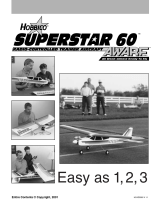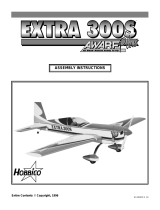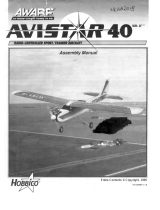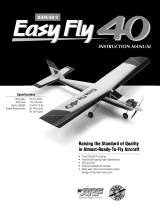
WARRANTY
Thunder Tiger Model Company guarantees this model kit to be free from defects in both material and
workmanship at date of manufacture. This warranty does not cover any components damaged by use
or modification and in no case shall Thunder Tiger’s liability exceed the original purchase price of the kit.
Thunder Tiger also reserves the right to change or modify this warranty without notice.
Since Thunder Tiger Model Co. has no control over possible shipping damages, construction techniques
or materials used for construction by the modeler, no liability can be assumed nor accepted for damage
resulting from the use by the user of the final user-assembled product. By the act of using this user-
assembled product, the user accepts all resulting liability. If the buyer is not prepared to accept this lia-
bility, he should return this kit in new and unused condition to the place of purchase for a full refund.
Assembly Instructions
U.S. Distributor: Ace Hobby Distributors, Inc., 116 W. 19th ST, Higginsville, MO 64037 (800) 322-7121
TTR4108
Specifications
Wing Span: 60.25 in (1530 mm)
Wing Area: 510 in2(33 dm2)
Weight: 22 oz. less/eng (.65 kg)
Engine: .10
Radio: 2/3 Channel w/mixer
and mini servos

2
INTRODUCTION
3
ITEMS NEEDED
INTRODUCTION
Your V-Bat goes together very quickly and offers you a unique and exciting airplane once you get it
airborne. A few notes before you begin.
1. You will need an electronic mixer for elevons. Either you need a transmitter capable of such mixing
or you will need an on-board mixer that plugs in between the receiver and servos. If you go the on-board
route, we recommend the Ace R/C SimpleMix (P/N AQ0616). It is a small, lightweight, and inexpensive
device that is designed primarily for this application. If you are using an on-board mixer, you will also
need two six inch servo extension cables
2. The instructions will show the installation of an on-board mixer. If you are using a mix capable trans-
mitter, disregard the on-board mixer and plug the servos directly into the receiver.
3. The V-Bat is configured to accommodate Hitec S-101 Mini Servos. If you are using different servos,
you may need to do some fitting.
4. The supplied optional engine pod is set-up for a Thunder Tiger GP-10 engine. If you use a different
engine, some re-work may be required.
5. Once installed, the flight pack battery is not removable. This means you must use rechargeable bat-
teries. The compartment is set-up for a AA sized flat pack or smaller.
Now that we have the preliminaries out the way, let’s hit the workbench.
The first thing you should do before beginning assembly is to check the contents of your kit against
the parts list on pages 4 and 5. If any parts are missing, contact your dealer immediately for
replacement. Customers in the United States and Canada may contact Ace Hobby Distributors direct-
ly at 116 W. 19th Street, Higginsville, MO 64037 660-584-6704 for replacement parts. Under no cir-
cumstances can a kit be returned if assembly has already been started.
Adhesives - You will need some epoxy to
assembly your V-Bat. We recommend that you
purchase both 5-minute and 30-minute epoxy to
cut down on assembly time, but you can get by
with only 30-minute epoxy if time is not impor-
tant.
Tools - Model assembly can be much easier if
the proper tools are used. Therefore, we have
included in our checklist to the right, a complete
listing of all the tools we used to assemble our
prototype models. As you will notice, many house-
hold tools can be utilized during construction.
Engine - The Thunder
Tiger GP-10 is the ideal
engines for this air-
plane. It is quiet-run-
ning engines and easy
to start, requires no
special break-in period,
is very easy to maintain and will last for years.
Flight Equipment - There are several “support”
items that you will need to purchase in order to
get your engine running and your plane in the
air. These are listed at the bottom of the page.
Check List
❏.10 Size Engine (optional)
❏2 or 3-Channel Radio with 2 Mini Servos
❏Mixing capable transmitter or On-Board Mixer
❏5-minute Epoxy (4 ounces)
❏30-minute Epoxy (4 ounces)
❏Hobby Knife and Blades
❏Epoxy Mixing Sticks and/or Brushes
❏Masking Tape
❏Rubbing Alcohol
❏Paper Towels
❏Ruler
❏Fine-Point, Felt-Tip Pen
❏Misc. Household Tools
❏Drill and Bits (1/16", 3/32", 5/32",)
Flight Equipment
❏Stick on Lead Strip for Balancing the Plane
❏Prop (see engine instructions)
❏10%-15% Glow Fuel
❏Fuel Pump or Bulb
❏Electric Starter or “Chicken Stick”
❏Glow Plug Clip and Battery
❏Extra Glow Plug(s)
Radio - A 2-3-channel radio with two mini
servos is required. Either a mixing capable
transmitter or an on-board mixer is required.
Also, an AA flat ni-cd receiver pack is needed.

5
PARTS SKETCHES
4
PARTS SKETCHES
IMPORTANT
Please check the contents of your kit box with these part sketches before beginning construction. This
will not only familiarize you with the parts and their names, but it will also give you a head start in the
unlikely event that you are missing a part. If parts are missing, call (660) 584-6704.
Parts are not necessarily drawn actual size! Parts are not necessarily drawn actual size!
Replacement parts can be ordered by Set Number Only.
Individual parts not available.
AS6108 Wing Set
Left Wing (1) Right Wing (1)
Tape (4) Wing Joiner (2)
Silicone Tube (1) Straight Nipple (1) Fuel Stopper (1)
75c.c Tank (1)
Cap (1)
Clunk (1)
90-degree Nipple (1)
3271 Fuel Tank Set
PE0009 Hardware Set
AS6109 Control Horn Set
AS6110 Hatch
Control Horn (2) 2mmx15mm Screw (4)
Tow Hook (1)Clevis (2)Backplate (2)
Allen Wrench (1)
Rod Connector (1)
Set Screw (1) 2mm Nut (1)
Left/Right Hatch (2) PVC Plate (2)
2mmx5mm Wood Screw (4) 2.6mmx8mm Wood Screw (3)
6/32x18 Screw (2)
AS6111 Engine Pod
3mm Nut (2)
3mmx12mm Screw (4) Spring Washer (4) Push Rod (2)
Fuselage(1)
AS6107 Fuselage
AS6112 Vertical Fin/Tip
AS6113 Decal
2mmx8mm Wood Screw(4)
Left Fin Right Fin
Decal (1)
Engine Pod (1)

7
RADIO INSTALLATION
6
RADIO INSTALLATION
RADIO INSTALLATION
Because of the small size of this plane and
the fact that the radio is imbedded in the wing,
installation is the most tedious part of the V-Bat.
We suggest that the radio be installed
before the wing halves are joined. This makes
it easier to get the wires routed.
❏Begin by cutting the covering material from
the servo hatch area in the bottom of each wing
half. Cut the material in an “X” fashion from cor-
ner to corner. Then use a heat iron to seal the
material to the inner edges of the hatch area.
Trim away excess material.
❏Next, use epoxy to laminate the two dihedral
braces together, keeping the holes lined up.
Clamp together as the glue sets. Wipe off
excess glue with a paper towel wetted with rub-
bing alcohol.
❏Prepare your servos as shown, using your
longest servo arm and the “EZ” connectors fur-
nished.
❏Install your receiver in the left wing.
There is a tube in the interior of the wing
which you may use for an antenna tube. In the
prototype, since our antenna was too long, we
simple taped the antenna to the trailing edge of
the wing and let the excess trail out the tip.
❏Install the servo next. Notice there is a rec-
tangular hole in the root of the wing for the
cables to pass through. You may need to open
this hole up to get the connectors to clear.
❏The servo is held in place with the furnished
plastic strap and two wood screws. You will
have to drill holes accordingly.
❏Linkage to the elevon is with a threaded rod,
nylon clevis, and control horn.
❏We chose to mount the switch in the rear
area of the opening. To gain clearance, we
have to remove the bottom switch cover.
❏Once you are all done, the hatch is held in
place with a few pieces of clear tape or the
screws furnished. We had to do some trimming
on the prototype to clear the servo linkage and
the cables going into the receiver.
❏Now, in the same fashion, install the servo,
its linkage, and the on-board mixer (if used) in
the right wing.
❏Trial fit the dihedral brace in the wing. Trim if
needed.
❏Epoxy the dihedral brace in the left wing half,
making sure the hole in the brace lines up with
the hole in the wing’s interior. Wipe away any
excess epoxy on the root of the wing.
❏Route the battery pack cable next. It goes
from the battery compartment through the dihe-
dral brace and into the servo compartment in
the left wing half. Some trimming of material
may be necessary for clearance. You will need
a piece of 1/16” or smaller music wire to “fish”
the wire through the holes. Poke the wire
through from the servo compartment to the bat-
tery compartment, tape the battery connector to
the wire, and pull the music wire back into the
servo compartment. Hold your tongue right and
it will work!

89
WING ASSEMBLY
❏It is time to join the wings. Epoxy the fuse-
lage to the left wing. Make sure you keep the
area where the engine pod inserts clear of glue,
otherwise the engine pod won’t slip into place.
❏After the glue has set, test fit the right wing
panel. Make sure the cables thread properly
into the right wing. When satisfied, apply epoxy
to the dihedral brace and the fuselage and join
the right wing panel in place. Of course, you
have to thread the cables through the root rib.
Once again, make sure the slot for the power
pod remains clear of glue.
❏Some white covering material is provided to
iron over the joint on the top of the wing.
❏The two wing tiplets are attached with two
screws. You will have to drill holes for the
screws in both the tiplets and the wing tips.
❏If you use the optional engine pod, mount the
engine on the right side of the pod with the fur-
nished hardware. Plumb the tank and mount it
with a rubber band on the left side of the pod.
❏If you have a three or more channel radio and
an engine with a throttle, you can mount a servo
to the pod on the right side opposite the tank.
Snake the cable down the pod and around the
rear of the wing into the receiver area.
❏The pod is slid into the slot provided and
secured with two bolts/blind nuts.
❏A tow hook is provided to install in the
recessed area in the bottom of the fuselage.
Drill a pilot hole before screwing it in.
❏Apply the peel and stick decals by trimming
close to the design and putting them where
desired. Refer to the box art for suggested loca-
tion. For the larger designs, spray the area with
window cleaner first, then squeegee out the
excess with the edge of a credit card.
CENTER OF GRAVITY/
BALANCE POINT
Before flight, check for the proper balance.
The V-Bat should balance on the rearmost edge
of the servo hatch cutout; or, 8-3/4” back from
the leading edge point. Add lead ballast as
needed.
You should set-up your mixer so the ratio of
elevator control is about 40% less that aileron
control. Otherwise, the V-Bat will be too pitch
sensitive. Following are the approximate throws
you should start with. They are measured at the
rear edge of the elevons.
You will find that the V-Bat is very fast, sta-
ble, and maneuverable. The glide ratio without
the engine pod is incredible due to its light
weight and efficient airfoil. On a high start or
winch it will climb like a rocket and settle down
quickly to assume a thermal search pattern. On
the slope, it will keep up with the best of them.
Actually, the V-Bat is a highly competitive slope
racer!
If you are flying with the power pod and with-
out a throttle, make your first flights with only
1/4th tank of fuel. Give yourself a chance to get
used to the plane before committing to a full
tank. A GP10 runs for quite awhile on 2-1/2
ounces!
Thank you for choosing Thunder Tiger. We
welcome your comments.
Full Right Aileron Deflection: Right elevon moves 1/2” up
Left elevon moves 1/2” down
Full Left Aileron Deflection: Right elevon moves 1/2” down
Left elevon moves 1/2” up
Full Up Elevator Deflection: Both elevons move 5/16” up
Full Down Elevator Deflection: Both elevons move 5/16” down
FLIGHT
/








